Jet mills can easily grind various new materials that are brittle, of high hardness and high purity. These materials include lithium iron phosphate, ceramics, silicon-based materials, carbon-based materials, western medicines, and chemical materials. They produce powders with fine particle size, a narrow particle size distribution and high purity. Jet mills are capable of reducing various materials to micron or even nano-sized particles, leading to their widespread application across numerous industries.
There are many types of jet mills, each with different working principles and varying effectiveness for grinding different materials. Therefore, selecting the appropriate струйная мельница based on the specific material is crucial. Mainstream jet mills currently on the market include fluidized bed jet mills, opposed jet mills, flat (disc) jet mills, circulating tube jet mills, and target (paddle) jet mills. Building upon these base designs, methods such as inert gas protection, cryogenic air, or liquid nitrogen freezing can be incorporated to optimize the grinding performance of the jet mill.
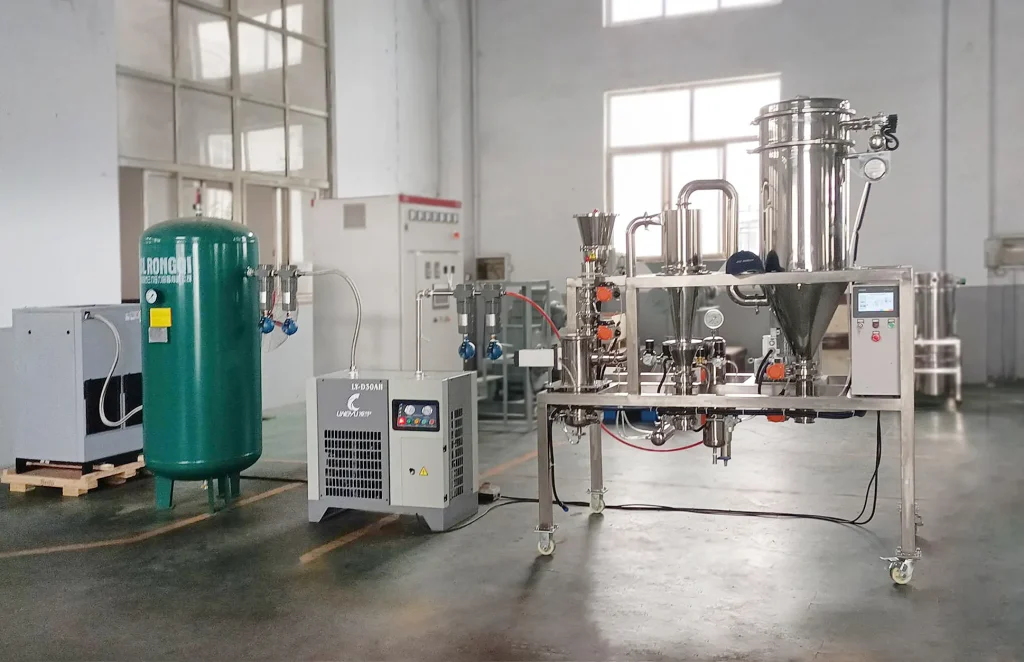
How to Choose the Right Jet Mill
The fluidized bed jet mill is the most mainstream type on the market. In fact, unless otherwise specified, references to ‘jet mills’ often implicitly mean this type. Fluidized bed jet mills are commonly used for grinding materials like chemical raw materials, pharmaceuticals, cosmetics, advanced ceramics, and magnetic powders.
In a fluidized bed jet mill, material is grinded in a gas-expanded state. The grinding chamber temperature is controlled at room temperature and does not increase, making it particularly suitable for heat-sensitive materials. Furthermore, fluidized bed jet mills incorporate the advantages of opposed jet mills. It can utilize the gas stream to propel particles into high-speed collisions with each other for grinding, with minimal impact against the equipment walls. This results in advantages like a narrow particle size distribution, high grinding efficiency, low energy consumption, minimal product contamination, and low wear on parts. They are suitable for grinding materials with a Mohs hardness of 9 or higher.
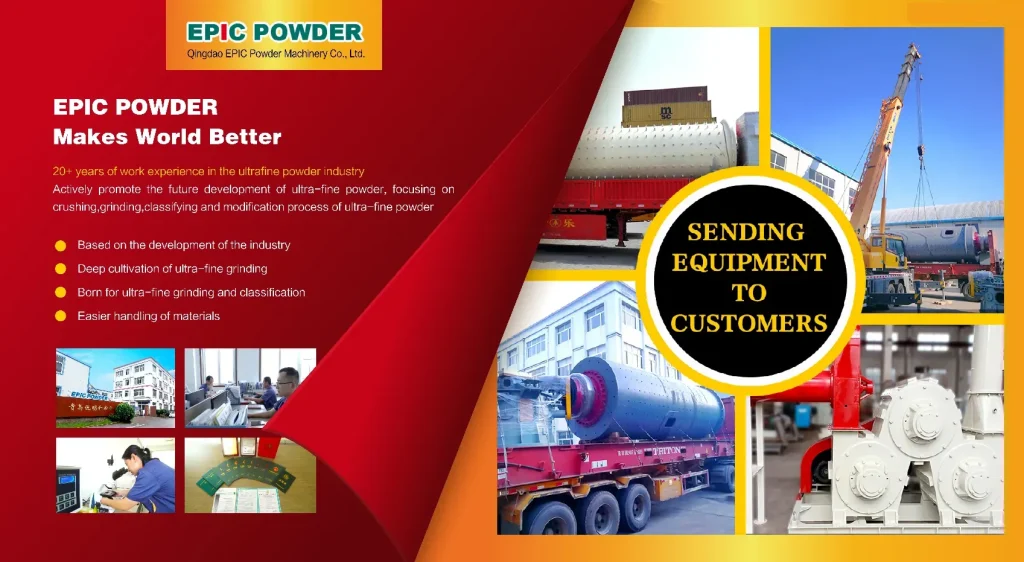
One of the biggest disadvantages of fluidized bed jet mills is their high cost. Another is that the feed material must be in a fluidized state to be grinded by the supersonic jets. Consequently, the feed material needs to have sufficient fineness. The feed particle size is typically required to be ≥ 30 mesh; the finer the raw material, the higher the output.
Epic Powder Fluidized Bed Jet Mill Working Principle
A complete grinding system consists of a high-pressure gas source system, the main jet mill host, a cyclone collector, a dust collector, an induced draft fan, and a control cabinet. Filtered high-pressure gas is injected into the grinding chamber at supersonic speeds through Laval nozzles. After grinding, under the action of the classification system, fine and coarse particles are separated. Particles meeting the size requirements are collected downstream, while coarse particles return to the grinding zone for further processing.
Epic Powder Fluidized Bed Jet Mill Operating Parameters
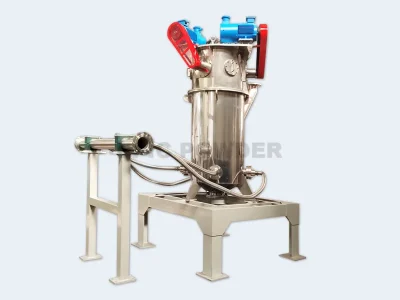
Product Fineness: Controllable range of 2µm ~ 150µm. Particle size distribution can be directly controlled via frequency conversion. It can achieve D97 ≤ 2µm finest size, with high precision and narrow distribution.
Feed Particle Size: ≥ 30 mesh. Finer raw materials yield higher output; a pre-grinder is recommended for coarser raw materials.
Feeding Method: Utilizes a hopper + frequency-controlled screw feeder for controlled, quantitative feeding.
Discharge Method: grinded, qualified material is collected via a dust collector or cyclone discharger. Discharge methods like electric discharge valves, pneumatic butterfly valves, or manual butterfly valves can be installed as per customer requirements.
Product Quality: The entire MQW series jet mills employ advanced technical drawings and European/American design processes, ensuring mature technology, efficient operation, and high stability.
Working Environment: No special workshop requirements. Dust-free and pollution-free operation due to negative pressure system.
Temperature Control: The jet mill provides constant temperature control, allowing 24/7 continuous production year-round with no temperature rise; maximum temperature ≤ 25°C.
After-sales Warranty: All MQW series jet mills come with a 3-year warranty (excluding wear parts and electrical components).
Quality Assurance: All company products are ISO9001 quality certified and ISO14001 environmental management certified.
Противоположная струйная мельница
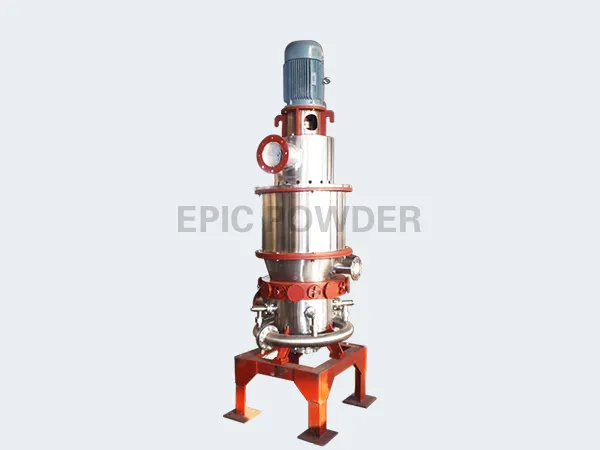
Also known as a counter-jet mill or reverse jet mill, this equipment works by accelerating two streams of material. These streams meet high-speed gas flows and collide at a specific point for grinding. The ground fine particles then enter an external classifier with the airflow. Under the classifying rotor’s action, they undergo gas-solid separation to become the final product.
Because the grinding mechanism of the opposed jet mill primarily relies on high-speed collisions between particles – the impact speed being the vector sum of the two opposing gas stream velocities – it achieves highly efficient grinding. This equipment features strong impact force, fast grinding speed, high energy utilization, and produces fine product particles. It is particularly suitable for grinding hard, brittle, or sticky materials. Furthermore, as its working principle is based on particle-to-particle impact, it avoids wear on fixed impact parts caused by high-speed jets, enabling the production of high-purity micro-nano powders.
Плоская (дисковая) струйная мельница
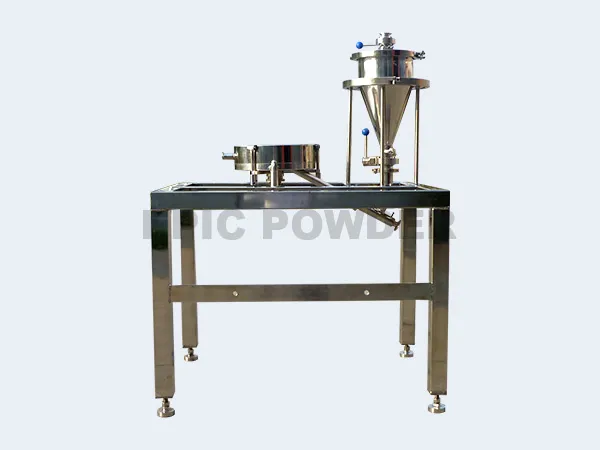
The flat jet mill, also known as a disc mill, is the world’s earliest type of jet mill. The first commercially viable flat jet mill was developed by the U.S. company Fluid Energy in 1934. Disc jet mills have the advantages of simple structure and easy operation; disassembly, cleaning, and maintenance are very straightforward. They also feature self-classification and are suitable for grinding brittle and soft materials.
The disadvantage of the дисковая струйная мельница is that when grinding harder materials, the intense collision and friction with the material can damage the grinding chamber walls, causing some product contamination. Therefore, it is unsuitable for grinding high-hardness particles. Additionally, a significant portion of the energy in a flat jet mill is wasted; energy consumption increases exponentially as the product fineness decreases during grinding. Materials are typically only processed to around D50=1µm.
A conventional дисковая струйная мельница has a disc-shaped grinding chamber. This chamber is surrounded by 6-24 high-pressure nozzles. It also includes a Venturi feeder and a product collector. Feed material is entrained by gas into the Venturi feeder. There, it is accelerated to supersonic speed. Inside the chamber, material moves in a high-speed vortex. This causes inter-particle collision and impact with the walls. Coarse particles are thrown outward for further grinding. Fine particles are carried by airflow to the collector.
Circulating Tube Jet Mill
The circulating tube jet mill/classifier offers notable benefits. It performs grinding and self-classification without a powered classifier. The unit is compact yet offers large capacity. It is ideal for brittle, low-hardness materials, achieving 3~0.2µm fineness with minimal wall adhesion. However, it has key limitations. The inner walls suffer severe erosion and wear from the high-speed flow. This results in low grinding efficiency and high energy consumption. Consequently, it is unsuitable for processing harder materials.
The circulating tube jet mill (vertical loop jet mill) is another type of self-classifying jet mill, typically categorized into constant circular cross-section and variable cross-section types, with the latter being most common today. The main structure is a looped pipeline with variable curvature and diameter (“O” shaped). During operation, compressed gas is ejected at high speed from the feed injector, creating a vacuum in the feed mixing chamber to automatically draw in material. The feed material is then accelerated by a Venturi tube into the lower grinding chamber of the “O” loop.
Multiple supersonic nozzles inject high-speed jets into the grinding chamber at different angles, causing the material to collide, rub, and shear, resulting in grinding. The grinded material enters the upper classification chamber of the “O” loop with the airflow. Coarse material returns along the outer diameter of the classification loop to the grinding chamber under centrifugal force, while fine material exits the loop with the centripetal airflow and can undergo secondary classification in a volute-shaped chamber with a smaller radius of curvature.
Target (Paddle) Jet Mill
In practical production, target jet mills can use target plates of different shapes based on material properties and desired product fineness. They offer good adjustability for feed direction. Their grinding force is relatively high, enabling them to handle fairly tough materials. They are often used for grinding polymeric polymers, low-melting-point heat-sensitive materials, and fibrous coarse materials.
Disadvantages include susceptibility to wear and severe erosion of the target plate and mixing tube, requiring regular part replacement. This can cause some material contamination. The product particle size distribution tends to be wider, and kinetic energy consumption is relatively high.
Also known as a single-jet impact mill, its working principle primarily involves using a high-speed gas stream to carry material and impact onto various shaped movable or fixed target plates for grinding. Additionally, particles undergo multiple rebound collisions within the grinding chamber walls. The grinded material is then discharged with the airflow through the outlet into a classifier.
We’ve discussed five common types of jet mills, but the most frequently encountered is still the fluidized bed type. If you have procurement needs for a jet mill, you can consult Epic Powder Mill at 86-157-6227-2120. Now, let’s discuss how to choose the grinding medium.
Inert Gas Protection
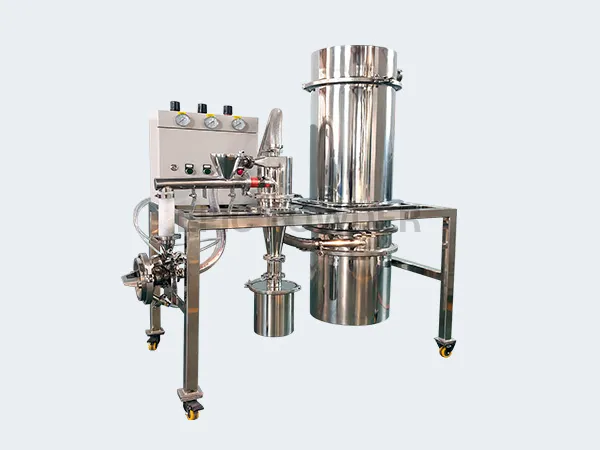
Many modern industrial processes involve flammable, explosive, or easily oxidizable powder materials that require ultrafine grinding. To ensure process safety, inert gases (such as nitrogen, argon) are typically used as the grinding medium in jet mills to achieve dry ultrafine grinding. During operation, the jet mill system is first purged by continuously introducing inert gas to displace air until the oxygen level detected by an oxygen analyzer reaches a preset safe value. The feeding device is then started to begin material grinding.
Cryogenic Jet Milling Process
For materials that are tough but require ultrafine grinding, a cryogenic pre-cooling process can be employed. Cryogenic jet milling primarily uses liquid nitrogen (reaching -196°C) as the coolant for heat exchange with the material, cooling it to a brittle state. The embrittled material is then subjected to numerous impacts within the grinding chamber by the milling mechanism, eventually becoming fine particles. The fineness of the grinded material can reach the micron level (600~2000 mesh). To save costs, for materials with less stringent cooling/embrittlement temperature requirements, pre-cooled air from chillers or cold air generators can be used for heat exchange with the material.
Currently, the cryogenic jet milling process is widely used for the superfine grinding of low-melting-point, heat-sensitive materials in industries like polymers, chemicals, rare earths, biology, food, pharmaceuticals, and health products. It can also be used for ultrafine grinding of flammable, explosive, or oxidizable materials, though it is generally more expensive than using inert gas protection.
Partner with Epic Powder for Your Milling Needs
At Epic Powder, we specialize in providing advanced jet milling solutions tailored to your specific material requirements and production goals. Our expertise spans the entire range of fluidized bed, flat (disc), and other jet mill technologies, including systems integrated with inert gas protection and cryogenic capabilities. We understand that selecting the right grinding technology is crucial for achieving optimal product quality, efficiency, and cost-effectiveness.
Our team of engineers is ready to assist you in choosing the ideal jet mill configuration and process parameters for your application. We are committed to delivering not only high-performance equipment but also comprehensive technical support and reliable after-sales service.
Contact Эпический порошок today at 86-157-6227-2120 to discuss how we can help you achieve superior results in your powder processing operations.